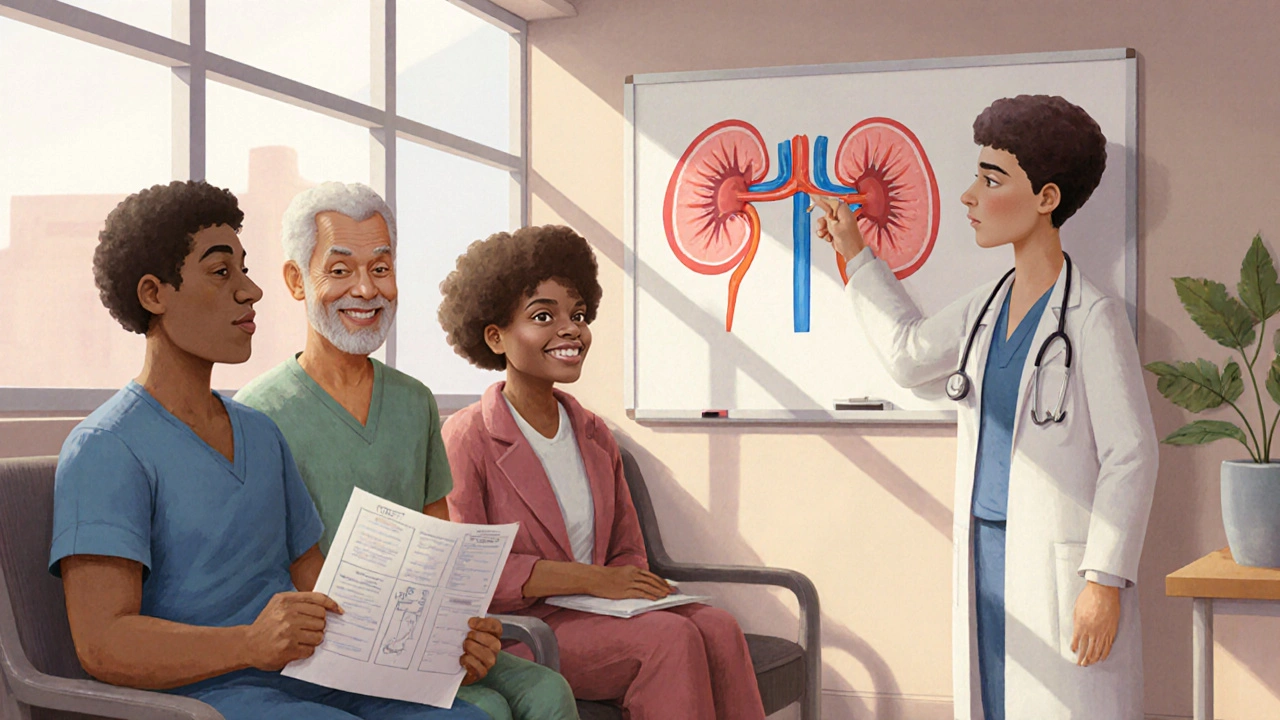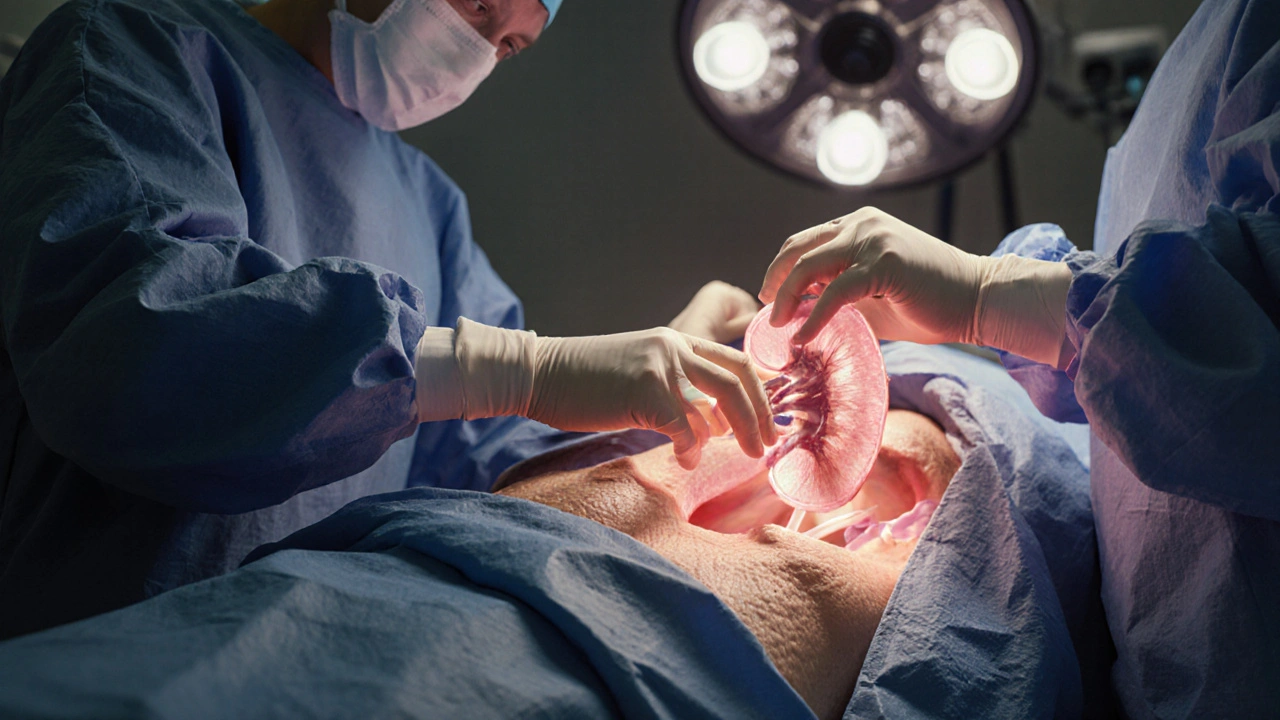Kidney Transplant: What You Need to Know About Eligibility, Surgery, and Lifelong Care

Nov, 14 2025
What Is a Kidney Transplant and Why It Matters
A kidney transplant isn’t just another surgery-it’s a life-changing reset for people with end-stage renal disease (ESRD). When your kidneys drop below 15% of normal function, they can’t filter waste or balance fluids anymore. Dialysis keeps you alive, but it’s exhausting, time-consuming, and doesn’t restore quality of life like a healthy transplanted kidney can. In fact, people who get a transplant live longer: about 85% are still alive five years later, compared to just 50% on dialysis. That’s not a small difference-it’s the difference between being tethered to a machine and being able to travel, work, or play with your grandkids.
Who Qualifies for a Kidney Transplant?
Not everyone with kidney failure gets on the transplant list. Centers have clear rules, and they’re not just about kidney numbers. Your glomerular filtration rate (GFR) needs to be 20 mL/min or lower to qualify. Some centers, like Mayo Clinic, may consider you if your GFR is up to 25 mL/min-but only if your kidney function is dropping fast (at least 10 mL/min per year) or you already have a living donor lined up.
Age doesn’t automatically disqualify you. UCLA doesn’t set a hard cutoff, but they do look closely at older patients. If you’re 75 or older, Vanderbilt says it’s a red flag, but not a dealbreaker. What matters more is how well your heart, lungs, and body hold up under stress. A 78-year-old with strong bones, clear lungs, and no heart issues might be a better candidate than a 60-year-old with uncontrolled diabetes and blocked arteries.
Body Weight and Surgical Risk
Obesity is one of the biggest barriers to transplant eligibility. A BMI over 35 is a warning sign. Over 45? Most centers will say no-until you lose weight. Why? Extra fat makes surgery harder, increases infection risk, and doubles the chance of the new kidney failing within five years. A 2022 study in the American Journal of Transplantation found obese patients had 35% more surgical complications and 20% higher graft failure rates. You don’t need to be skinny, but you do need to be healthy enough to survive the operation and take care of the new organ.
Heart and Lung Health: Non-Negotiables
Your heart and lungs have to be strong enough to handle major surgery and lifelong immunosuppressants. If you have severe pulmonary hypertension-right ventricle pressure above 50 mm Hg-you’re likely ineligible. Vanderbilt sets an even stricter line: if your pulmonary artery pressure hits 70 mm Hg or higher, they won’t move forward. Same goes for oxygen dependence. If you need to carry an oxygen tank just to walk to the bathroom, that’s a red flag. Your heart needs an ejection fraction of at least 35-40%. That means your heart pumps out enough blood with each beat to keep your new kidney alive.

The Evaluation Process: More Than Just Blood Tests
Getting on the list isn’t a quick appointment. It’s a months-long process. You’ll go through blood tests, cancer screenings, chest X-rays, EKGs, and tests for viruses like HIV, hepatitis, and CMV. But the real depth comes in the psychological and social checks.
Nebraska Medicine requires you to have a care partner-someone who will remind you to take pills, drive you to appointments, and call the clinic if something feels off. Penn Medicine checks your mental health history. If you’ve had untreated depression, bipolar disorder, or active substance abuse, they’ll pause your application. You don’t need to be perfect, but you need to be reliable. Taking immunosuppressants every single day, for life, isn’t optional. Miss a dose, and your body could reject the kidney within days.
What Disqualifies You Forever?
Some things are absolute dealbreakers:
- Active cancer-unless you’ve been cancer-free for a set time (usually 2-5 years, depending on type)
- Untreated HIV with low CD4 count or detectable viral load
- Active hepatitis B with detectable virus in the blood
- Uncontrolled substance abuse-alcohol, opioids, meth, or cocaine
- Severe untreated mental illness that prevents medication adherence
These aren’t just rules-they’re survival guidelines. A transplant doesn’t fix addiction or cancer. It just gives your body a new organ to fight against. If you’re not ready to change, the transplant won’t work.
The Surgery: What Happens in the Operating Room
The surgery takes 3 to 4 hours. You’re under general anesthesia. The surgeon places the new kidney in your lower belly, connects its artery and vein to your own blood vessels, and attaches the ureter to your bladder. Your original kidneys? Usually left in place. They’re not removed unless they’re infected, causing high blood pressure, or too large to leave safely.
The new kidney often starts making urine right away-sometimes even before you wake up. But in about 20% of cases, especially with kidneys from deceased donors, it takes a few days to kick in. That’s called delayed graft function. You might need dialysis for a week or two while the kidney recovers. It’s not failure-it’s just a slow start.

Life After Transplant: The Real Work Begins
Getting the kidney is only half the battle. The other half is keeping it alive. You’ll take immunosuppressants every day, for the rest of your life. That means a mix of drugs-usually tacrolimus or cyclosporine, mycophenolate, and a steroid like prednisone. These drugs stop your immune system from attacking the new kidney. But they also weaken your defenses against infections and raise your risk for certain cancers, diabetes, and high blood pressure.
Follow-up visits are strict: weekly for the first month, then monthly for the next few months, then every three months. After that, you’ll still need annual checkups forever. Blood tests, urine tests, ultrasounds-they’re all part of the routine. You’ll learn to recognize the signs of rejection: fever, swelling, weight gain, decreased urine output, or pain near the transplant site. Catch it early, and it’s often reversible.
Living Donor vs. Deceased Donor: The Numbers Don’t Lie
If you have a living donor-say, a sibling, spouse, or even a friend-you’re in the best possible position. Living donor kidneys last longer. One-year survival? 97% for living donor transplants versus 93% for deceased donor. Five-year survival? 85% versus 78%. Why? Because the kidney is healthy, fresh, and doesn’t spend hours or days in cold storage. It goes from one body to another in under an hour.
Deceased donor kidneys come from people who’ve died. They’re still life-saving, but they’re more likely to have been damaged by illness, trauma, or long wait times. The Kidney Donor Profile Index (KDPI) helps match kidneys with the longest expected life to recipients who need them most. Even high-KDPI kidneys-those from older donors or donors with health issues-still give you a better shot at life than staying on dialysis.
What’s Next? The Future of Transplants
Scientists are working on ways to reduce or eliminate lifelong immunosuppression. Clinical trials at Stanford and the University of Minnesota are testing tolerance-inducing therapies-training the immune system to accept the new kidney without drugs. If it works, it could change everything. For now, though, the best tool you have is consistency: take your pills, show up for appointments, eat well, and stay active. Your new kidney doesn’t need perfection. It just needs you to show up.
Can you get a kidney transplant if you’re over 70?
Yes, but it depends on your overall health, not your age. Centers like UCLA don’t have an age limit-they assess fitness, heart health, lung function, and mental readiness. If you’re 75 and active, with no major heart or lung disease, you could be a candidate. But if you’re frail, have severe diabetes, or need oxygen to breathe, your chances drop significantly. The goal isn’t to extend life-it’s to extend quality life.
How long do kidney transplants last?
On average, a kidney from a living donor lasts 15-20 years. A kidney from a deceased donor lasts 10-15 years. Some last longer-over 30 years in rare cases. But rejection, infections, or side effects from medications can shorten that. That’s why lifelong monitoring is critical. Many people get a second transplant if the first one fails.
Can you drink alcohol after a kidney transplant?
Moderation is key. Most transplant centers allow 1-2 drinks per week, but heavy drinking is dangerous. Alcohol can damage the new kidney, interfere with immunosuppressants, and raise blood pressure. Some centers require a 6-month alcohol-free period before transplant. After that, occasional drinking is usually fine-but never binge drink.
What happens if your body rejects the new kidney?
Rejection happens in about 10-20% of cases within the first year. Most are mild and caught early through blood tests. Doctors treat it by increasing immunosuppressant doses or adding new drugs. If rejection is severe or repeated, the kidney may fail. In that case, you’d return to dialysis and be re-listed for another transplant. Early detection saves kidneys.
Do you need to change your diet after a transplant?
Yes. You’ll need to avoid grapefruit and Seville oranges-they interfere with immunosuppressant drugs. You’ll also need to limit salt, sugar, and saturated fats to protect your heart and blood pressure. Protein intake should be moderate-too much can strain the kidney. A dietitian will help you build a plan that supports your new organ and balances medication side effects.
Can you get pregnant after a kidney transplant?
Yes, many women do. But it’s safest to wait at least one year after transplant, when the kidney is stable and medication doses are low. You’ll need close monitoring by both a nephrologist and an OB-GYN. Some immunosuppressants are safe during pregnancy; others aren’t. Planning ahead is critical-don’t assume you can get pregnant right away.
What to Do Next
If you’re considering a transplant, start by talking to your nephrologist. Ask for a referral to a transplant center. Don’t wait until you’re on dialysis-early evaluation gives you more options. If you have a potential living donor, encourage them to get screened. Every day you wait on the list is a day you’re not living your life. The system isn’t perfect, but a transplant still offers the best chance to get back to normal.
